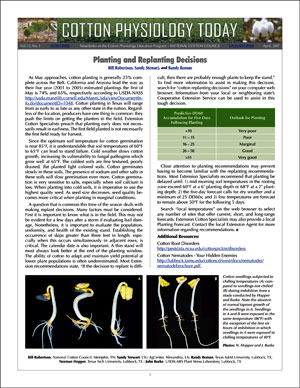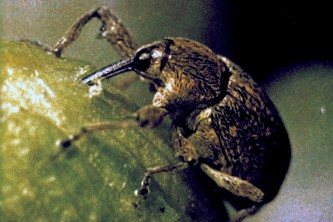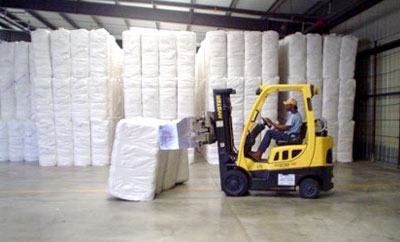Research/Education
 The Cotton Physiology Today newsletter was re-introduced in electronic format in 2007. |
The newsletter is produced by Dr. William C. "Bill" Robertson, who joined the NCC in early 2007 as manager, Cotton Agronomy, Soils and Physiology. Robertson also has responsibility for program planning and overall coordination of the annual Beltwide Cotton Production Conference. Robertson also coordinated the creation of a new “Cotton Consultants Conference” that was offered at the 2008 Beltwide Cotton Conferences.
The NCC put its support behind Cotton eXtension, a major educational effort that provides an interactive learning environment delivering the best and most complete source of unbiased research-based knowledge from land-grant universities across the Cotton Belt. eXtension is a new tool for Cooperative Extension educators, agents and specialists to use in engaging existing and new customers/clients.
Regulatory
Also joining the NCC’s Technical Services department, now led by NCC Vice President Bill Norman, was Dr. Donald “Don” Parker. Parker serves as manager, Integrated Pest Management and assists with management of The Cotton Foundation.
The EPA agreed that producers growing Bollgard II and Widestrike in specified areas no longer will be required to plant a structured, non-Bt cotton refuge – a move the NCC’s Environmental Task Force sought (natural refuge for all two-gene Bt products) during the agency’s review. The NCC also filed comments on EPA’s Advance Notice of Proposed Rulemaking regarding regulation of plant-incorporated protectants as a pesticide, noting that requiring additional labeling would be redundant and duplicative to the stewardship agreement.
A letter of support was submitted urging USDA’s Animal & Plant Health Inspection Service (APHIS) to proceed with the development of an Environmental Impact Statement (EIS) relative to the proposed use of genetically engineered insects, including pink bollworm, in ongoing pest control programs.
The NCC commented to EPA with product use data and support for continued use of aldicarb (Temik® insecticide).
The NCC filed comments with EPA in support of the continued use of the MSMA herbicide. NCC Environmental Task Force member Bowen Flowers told an EPA panel of the problems cotton producers might face with weed control if MSMA was cancelled, especially as glyphosate and ALS inhibitors are becoming ineffective in certain growing areas. The Clarksdale, MS, producer also was selected by USDA to serve on the Secretary of Agriculture’s Advisory Committee on Biotechnology and 21st Century Agriculture.
The EPA approved early season use of dicrotophos insecticide (Bidrin) after the NCC, AmVac representatives, entomologists and crop consultants demonstrated shifting pest pressures and the need for controlling foliar thrips.
The need for continued availability of carbofuran was conveyed to EPA. The NCC emphasized the insecticide’s effectiveness on cotton aphids when used under Section 18 emergency exemptions. The NCC also joined with other cotton interest organizations in meetings with EPA to finalize mitigation measures for aldicarb which will allow its continued use. In addition, the NCC continued to stay engaged with EPA as it considers the registration status of endosulfan.
 A Study Group was appointed to develop a proposed protocol for structuring and financing boll weevil post eradication efforts. |
EPA was asked by a coalition of 13 agricultural organizations that included the NCC to publish a final regulation requiring pesticide registrant’s participation in recycling empty, non-refillable plastic pesticide containers. The NCC believes a uniform, national recycling program offers the most effective incentive for proper rinsing and disposal of empty containers, as well as ensuring availability of inspection and collection centers.
Pest Management
The NCC’s Boll Weevil Action Committee reviewed the status of eradication for each state still in active eradication in 2007 and determined the program’s federal cost share funding allocation. The committee also is engaged in the establishment of a national quarantine program to 1) address potential outbreaks in areas where eradication is completed and 2) develop a post eradication plan as these efforts near completion. At the request of the previous year’s Boll Weevil Executive Committee, a Study Group was appointed to develop a proposed protocol for structuring and financing boll weevil post eradication efforts. The Study Group provided a brief report of their first meeting which focused on identifying needs, possible funding components, and beginning development of a framework that will serve to structure a workable system.
The NCC’s Pink Bollworm Action Committee reviewed 2007 program results and discussed plans for 2008. Programs in Phase I in Trans Pecos/El Paso; south and central New Mexico; and Chihuahua, Mexico all reported excellent progress in pink bollworm eradication. Phase II, initiated in ’06 in east and central Arizona, also reported an excellent first year. Expansion into western Arizona and adjacent areas of California occurred in ’07. Pheromone trap captures showed a late season migration of pink bollworm moths from areas not yet in the eradication program moving into eradication areas. The committee recognized the need to include remaining pink bollworm population areas into the eradication program in order to prevent a loss of progress.
Cotton Flow/Packaging
 NCC's Performance and Standards Task Force assisted the industry on several initiatives aimed at improving cotton flow. |
The Task Force was asked by the NCC’s Cotton Flow Committee to assist the industry in the development of a standardized warehouse scheduling tool and to study the field-to-fabric flow.
The NCC also began a weekly posting on its web site of the number of warehouse operators failing to submit weekly reports of bales made available for shipment. Electronic warehouse receipt providers assisted warehouse operators with the new reporting requirement used by USDA to monitor compliance with the minimum shipping requirement for warehouses.
NCC members were asked – via an Action Alert – to urge their Congressional Members’ opposition to any USDA attempt to stop the implementation of warehouse storage credits for the 2008 fiscal year cotton marketing loan program. The NCC developed a paper summarizing the impact of the Farm Service Agency’s changes regarding cotton transfer procedures.
The NCC also responded to the USDA-APHIS proposal to increase fees charged for export certification of plants and plant products. The NCC argued in its comments that the fees are passed back through the marketing chain to producers and APHIS should consider lowering cotton’s fees because the industry’s self inspection programs allow APHIS to preserve scare agency resources.
A Cotton Belt tour for an Ecuadorian Phytosanitary Team was arranged that led that country to review and re-write its phytosanitary regulations for baled cotton. Included was the creation of a revised cotton export protocol eliminating Ecuador’s fumigation requirements.
The Joint Cotton Industry Bale Packaging Committee (JCIBPC) conducted its 40th annual meeting and voted to have packaging manufacturers supply end users of approved packaging products a certificate of analysis (voluntary in 2007, mandatory in 2008) – to ensure manufacturers adhere to industry standards. JCIBPC Chairman Lee Tiller also sent a letter to NCC member ginners and others reminding them of the importance of using only bale packaging materials approved by the JCIBPC and USDA’s CCC.
The JCIBPC also agreed on increased awareness of the need for producing uniform bales. The NCC and the National Cotton Ginners Association (NCGA) sent letters to state and regional gin and warehouse associations urging gins to accept the challenge of producing well-packaged bales of uniform size, shape and density. NCC staff also addressed misshaped bales at various cotton warehouse association meetings and at the NCGA Ginners School.
The NCC facilitated a meeting in Memphis of the Agriculture Transportation Coalition (AgTC) / United States Chamber of Commerce with shippers of baled cotton, whole cottonseed, cottonseed products and other agricultural commodities. The Chamber is undertaking a major study of transportation infrastructure needs throughout the country. The meeting emphasized the importance of a healthy transportation sector to agribusinesses. The meeting also resulted in the Chamber’s request for additional cotton industry input regarding the U.S. agricultural transportation infrastructure and service needs.
On other technical issues, the NCC:
- Continued serving as a cooperator for the NCGA’s 2007 Ginner Schools
- Joined with other organizations in filing legal challenges under the 6th Circuit Court of Appeals against EPA’s final rule on National Pollution Discharge Elimination System permitting on the basis that it does not explicitly state that all agricultural production applications do not require a NPDES permit
- Submitted comments to the Department of Homeland Security asking them to reconsider and revise the chemical of interest list and thresholds to reflect real chemical security risks in their Chemical Facility Anti-Terrorism proposed regulations

